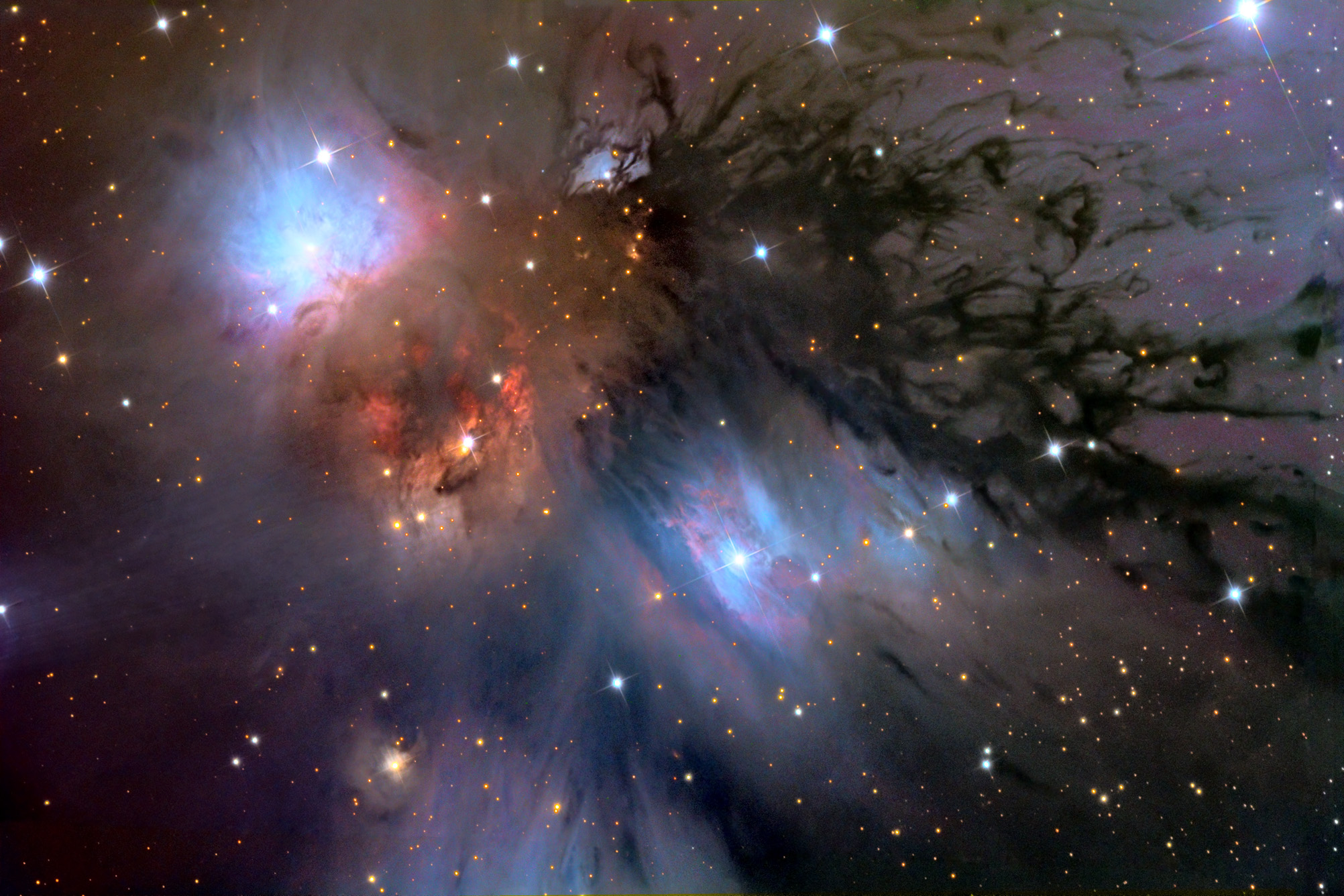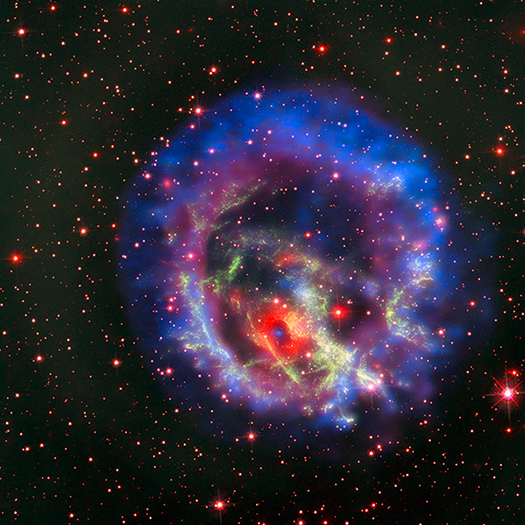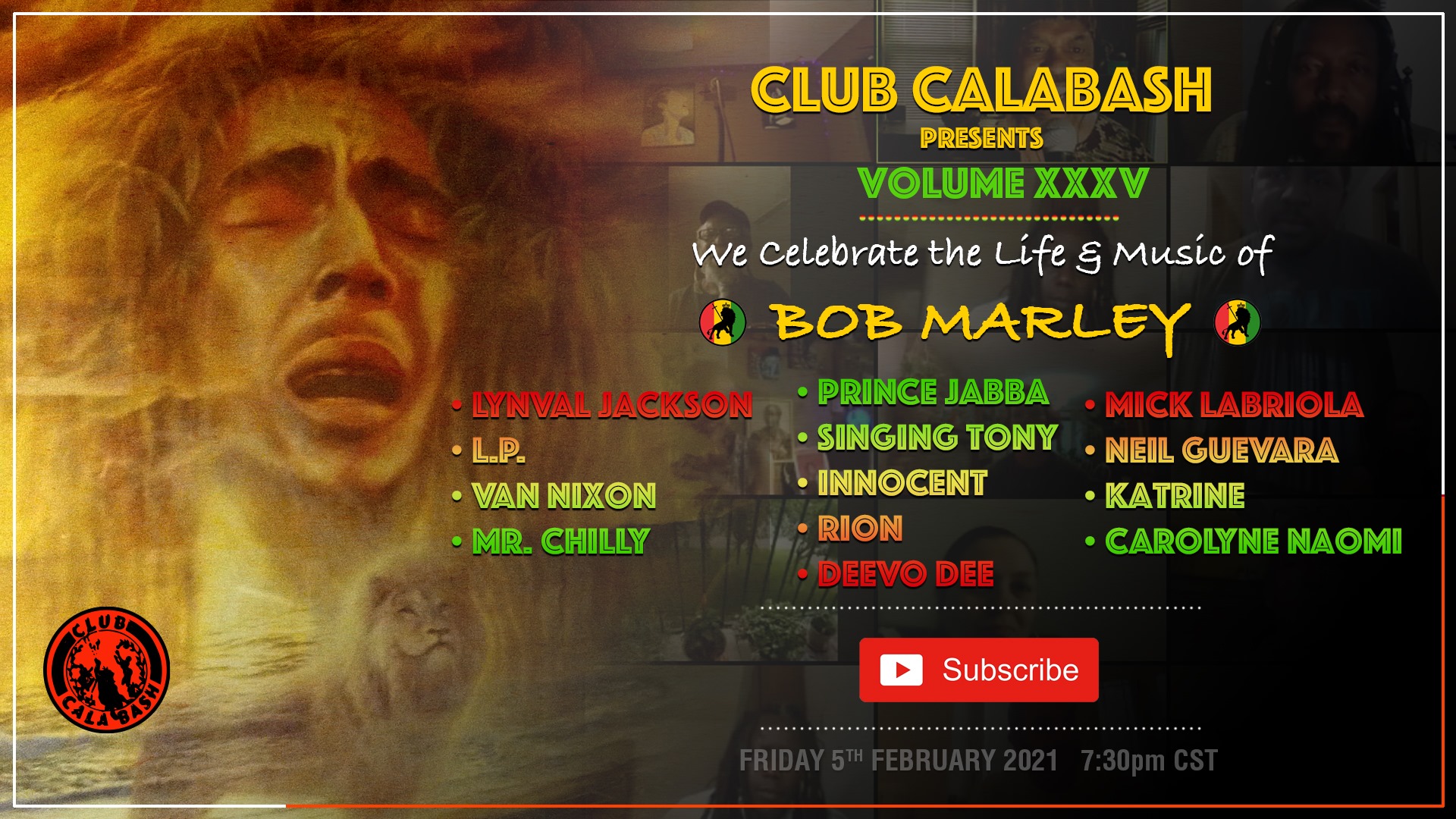Blog
NGC 7822 is a young star forming complex in the constellation of Cepheus. The complex encompasses the emission region designated Sharpless 171, and the young cluster of stars named Berkeley 59. The complex is believed to be some 800–1000 pc distant, with the younger components aged no more than a few million years. The complex also includes one of the hottest stars discovered within 1 kpc of the Sun, namely BD+66 1673, which is an eclipsing binary system consisting of an O5V that exhibits a surface temperature of nearly 45,000 K and a luminosity about 100,000 times that of the Sun. The star is one of the primary sources illuminating the nebula and shaping the complex’s famed pillars of creation-type formations, the elephant trunks.

Natalie Maria Cole (February 6, 1950 – December 31, 2015) was an American singer, songwriter, and actress. Cole was the daughter of American singer and jazz pianist Nat King Cole. She rose to success in the mid-1970s as an R&B singer with the hits “This Will Be“, “Inseparable” (1975), and “Our Love” (1977). She returned as a pop singer on the 1987 album Everlasting and her cover of Bruce Springsteen‘s “Pink Cadillac“. In the 1990s, she sang traditional pop by her father, resulting in her biggest success, Unforgettable… with Love, which sold over seven million copies and won her seven Grammy Awards. She sold over 30 million records worldwide.
Natalie Cole was born at Cedars of Lebanon Hospital in Los Angeles, to American singer and jazz pianist Nat King Cole and former Duke EllingtonOrchestra singer Maria Hawkins Ellington, and raised in the affluent Hancock Park district of Los Angeles. Regarding her childhood, Cole referred to her family as “the black Kennedys” and was exposed to many great singers of jazz, soul and blues. At the age of 6, Natalie sang on her father’s Christmas album The Magic of Christmas and later started performing at age 11.
https://www.youtube.com/watch?v=AnQTGdEHpIM
more...Robert Nesta Marley, OM (6 February 1945 – 11 May 1981) was a Jamaican singer, songwriter, and musician. Considered one of the pioneers of reggae, his musical career was marked by fusing elements of reggae, ska, and rocksteady, as well as his distinctive vocal and songwriting style.Marley’s contributions to music increased the visibility of Jamaican music worldwide, and made him a global figure in popular culture for over a decade. Over the course of his career Marley became known as a Rastafari icon, and he infused his music with a sense of spirituality. He is also considered a global symbol of Jamaican music and culture and identity, and was controversial in his outspoken support for the legalization of marijuana, while he also advocated for Pan-Africanism.
Born in Nine Mile, British Jamaica, Marley began his professional musical career in 1963, after forming Bob Marley and the Wailers. The group released its debut studio album The Wailing Wailers in 1965, which contained the single “One Love/People Get Ready“; the song was popular worldwide, and established the group as a rising figure in reggae. The Wailers subsequently released eleven further studio albums; while initially employing louder instrumentation and singing, the group began engaging in rhythmic-based song construction in the late 1960s and early 1970s, which coincided with the singer’s conversion to Rastafarianism. During this period Marley relocated to London, and the group embodied their musical shift with the release of the album The Best of The Wailers (1971).
The group attained international success after the release of the albums Catch a Fire and Burnin’ (both 1973), and forged a reputation as touring artists. Following the disbandment of the Wailers a year later, Marley went on to release his solo material under the band’s name. His debut studio album Natty Dread (1974) received positive reception, as did its follow-up Rastaman Vibration (1976). A few months after the album’s release Marley survived an assassination attempt at his home in Jamaica, which prompted him to permanently relocate to London. During his time in London he recorded the album Exodus (1977); it incorporated elements of blues, soul, and British rock, enjoyed widespread commercial and critical success.
In 1977, Marley was diagnosed with acral lentiginous melanoma; he died as a result of the illness in 1981. His fans around the world expressed their grief, and he received a state funeral in Jamaica. The greatest hits album Legend was released in 1984, and became the best-selling reggae album of all time. Marley also ranks as one of the best-selling music artists of all time, with estimated sales of more than 75 million records worldwide. He was posthumously honored by Jamaica soon after his death with a designated Order of Merit by his nation. In 1994, he was inducted into the Rock and Roll Hall of Fame. Rolling Stone ranked him No. 11 on its list of the 100 Greatest Artists of All Time.
more...John Pisano (born February 6, 1931) is a jazz guitarist born in Staten Island, New York. Pisano has worked with Herb Alpert, Billy Bean, Chico Hamilton, Peggy Lee, and Joe Pass.
more...Dusty nebula NGC 2170, also known as the Angel Nebula, shines near the image center. Reflecting the light of nearby hot stars, NGC 2170 is joined by other bluish reflection nebulae, a red emission region, many dark absorption nebulae, and a backdrop of colorful stars. Like the common household items that still life painters often choose for their subjects, the clouds of gas, dust, and hot stars featured here are also commonly found in this setting — a massive, star-forming molecular cloud in the constellation of the Unicorn (Monoceros). The giant molecular cloud, Mon R2, is impressively close, estimated to be only 2,400 light-years or so away. At that distance, this canvas would be over 60 light-years across.

Vincent Peter Colaiuta (born February 5, 1956) is an American drummer who has worked as a session musician in many genres. He was inducted into the Modern Drummer Hall of Fame in 1996 and the Classic Drummer Hall of Fame in 2014.
Of Italian descent, Colaiuta was given his first drum kit when he was seven. He took to it naturally, with little instruction. When he was fourteen, the school band teacher gave him a book that taught him some of the basics. Buddy Rich was his favorite drummer until he heard the album Ego by Tony Williams, an event that changed his life. Colaiuta was also listening to organ groups, notably Jack McDuff, Jimmy McGriff and Don Patterson.While a student at Berklee College of Music, when jazz fusion was on the rise, he listened to and admired Alphonse Mouzon and Billy Cobham. After leaving school, he played local gigs in Boston. He joined a brief tour organized by Al Kooper, then worked in California on an album by Christopher Morris, which Kooper was producing. Although he returned to Boston, he was drawn back to California by friends. He took the bus from Boston to Los Angeles during the blizzard of 1978. After performing in jazz clubs, he won the audition to play drums for Frank Zappa. He toured with Zappa and appeared on the albums Joe’s Garage, Tinsel Town Rebellion, and Shut Up ‘n Play Yer Guitar.
more...Al Kooper (born Alan Peter Kuperschmidt, February 5, 1944) is an American songwriter, record producer and musician, known for organizing Blood, Sweat & Tears, although he did not stay with the group long enough to share its popularity. Throughout much of the 1960s and 1970s, he was a prolific studio musician, playing organ on the Bob Dylan song “Like A Rolling Stone“, French horn and piano on the Rolling Stones song “You Can’t Always Get What You Want“, and lead guitar on Rita Coolidge‘s “The Lady’s Not for Sale“, among many other appearances. He also produced a number of one-off collaboration albums, such as the Super Session album that brought together guitarists Mike Bloomfield and Stephen Stills. In the 1970s he was a successful manager and producer, notably recording Lynyrd Skynyrd‘s first three albums. He has also had a successful solo career, written music for film soundtracks, and has lectured in musical composition. He continues to perform live.
more...Big Bill Bissonnette (February 5, 1937 – June 26, 2018) was an American jazz trombonist, drummer, and record producer.
He was a strong advocate of New Orleans jazz as played by veteran African-American musicians. In the 1960s, he led his own group, the Easy Riders Jazz Band, formed his own label, Jazz Crusade, and organized northern tours for Kid Thomas Valentine, George Lewis, and Jim Robinson. He produced over 100 recorded jazz sessions for Jazz Crusade and appeared as trombonist or drummer on over 50 recording sessions of New Orleans jazz.
The Easy Riders Jazz Band was one of the most acclaimed revival bands of the 1960s. Bissonnette brought Sammy Rimington to the United States. During his career, he worked with Alvin Alcorn, Red Allen, Jimmy Archey, Polo Barnes, Albert Burbank, Alex Bigard, Don Ewell, Pops Foster, George Guesnon, Edmond Hall, Bob Helm, Tuba Fats Lacen, George Lewis, Fred Lonzo, Alcide Pavageau, George Probert, Kid Sheik, Zutty Singleton, Victoria Spivey, Gregg Stafford, Michael White, and Kid Thomas Valentine.
more...Bulerías, like other flamenco forms, has its own language. When we dance we are in conversation with the singer, the guitarist, and the palmeros. The structure offers a formula for clear communication, and it looks like this:
-
Salida
-
Marcaje(s)
-
Paso de bulerías (or a more upbeat marcaje)
-
Llamada
-
Patá (Patada)
-
(Another Marcaje or Paso de Bulerías)
-
Llamada
-
Final
Clyde Austin Stubblefield on drums
more...Astronomers have discovered a special kind of neutron star for the first time outside of the Milky Way galaxy, using data from NASA’s Chandra X-ray Observatory and the European Southern Observatory’s Very Large Telescope (VLT) in Chile.
Neutron stars are the ultra dense cores of massive stars that collapse and undergo a supernova explosion. This newly identified neutron star is a rare variety that has both a low magnetic field and no stellar companion.
The neutron star is located within the remains of a supernova — known as 1E 0102.2-7219 (E0102 for short) — in the Small Magellanic Cloud, located 200,000 light years from Earth.
This new composite image of E0102 allows astronomers to learn new details about this object that was discovered more than three decades ago. In this image, X-raysfrom Chandra are blue and purple, and visible light data from VLT’s Multi Unit Spectroscopic Explorer (MUSE) instrument are bright red. Additional data from the Hubble Space Telescope are dark red and green.
Oxygen-rich supernova remnants like E0102 are important for understanding how massive stars fuse lighter elements into heavier ones before they explode. Seen up to a few thousand years after the original explosion, oxygen-rich remnants contain the debris ejected from the dead star’s interior. This debris (visible as a green filamentary structure in the combined image) is observed today hurtling through space after being expelled at millions of miles per hour.

John Stubblefield (February 4, 1945 – July 4, 2005) was an American jazz saxophonist, flautist, and oboist.
Stubblefield was an adaptable musician, having played with the World Saxophone Quartet (´86-´88), Reggie Workman (´89-´93), McCoy Tyner (´84 Clark), Freddie Hubbard (´85), and George Russell (´85). Stubblefield also served for a time as a jazz ensemble director at Rutgers University, following the departure of Paul Jeffrey in 1983.
more...Born February 4th 1938 and raised in Ashland, MS, guitarist Joe Beard grew up with the Murphy brothers, one of whom later found an international following as Matt “Guitar” Murphy. Beard moved to Rochester, NY, and from time to time would visit one of his brothers in Chicago. He quickly became enamored of the blues being played in clubs there by people like Jimmy Reed and Sonny Boy Williamson. Beard sat in with John Lee Hooker one night and received encouraging words from Hooker.
Beard befriended classic blues guitarist Son House, who was a neighbor in Rochester.. Beard worked as an electrician by day and would occasionally play out at night and on weekends for most of the ’60s on through to the ’80s. At Rochester’s famed BK Lounge, Beard and his backing bands opened for Bobby Bland, Albert King, and others.
Joe has played many major festivals in the US and Europe and was inducted to the Rochester Music Hall Of Fame in 2017. He has released 4 albums to great critical acclaim. One album featured Ronnie Earl and two others featured Duke Robillard.
more...Jutta Hipp (February 4, 1925 – April 7, 2003) was a jazz pianist and composer. Born in Leipzig in the Weimar Republic, she initially listened to jazz in secret, as it was not approved of by the Nazi authorities. After surviving World War II, she became a refugee, often lacking food and other necessities. By the early 1950s, she was a touring pianist and soon led her own bands. Critic Leonard Feather heard Hipp perform in Germany in 1954, recorded her, and organized her move to the United States the following year. Club and festival appearances soon followed, as did album releases.
For reasons that are unclear, Hipp’s last recording was in 1956; she started working in a clothing factory, and ultimately cut herself off from the music world. She remained in the United States, and worked for the clothing company for 35 years. Hipp was born on February 4, 1925 in Leipzig in the Weimar Republic. Her family was middle class, with a Protestant background. She began playing the piano at the age of nine.
more...More Posts
- Gil Coggins Day
- World Music with AL-Mawror
- Daily Roots with Carlton and the Shoes
- The Cosmos with N159W
- Malachi Favors Day
- John Lee Hooker Day
- World Fusion with Azam Ali
- Daily Roots with Jackie Mittoo
- The Cosmos with IC 1898
- Art Farmer Day
- Count Basie Day
- World Music with Lian Pearl Folk Music Band
- Daily Roots with Dennis Brown & George Nooks
- The Cosmos with NGC 5714
- Terry Clarke Day
- Robert Plant Day
- Isaac Hayes Day
- Jimmy Raney Day
- World Music with Maalem Mahmoud Guinia
- Daily Roots with Sylford Walker
